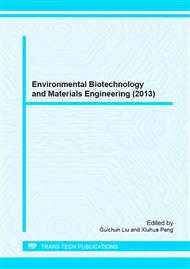[1]
T. Robinson, G. McMullan, R. Marchant, P. Nigam, Remediation of dyes in textile effluent: a critical review on current treatment technologies with a proposed alternative, Bioresource Technol, 77 (2001) 247-255.
DOI: 10.1016/s0960-8524(00)00080-8
Google Scholar
[2]
P.I.M. Firmino, M.E.R. Da Silva, F.J. Cervantes, A.B. Dos Santos, Colour removal of dyes from synthetic and real textile wastewaters in one- and two-stage anaerobic systems, Bioresource Technol, 101 (2010) 7773-7779.
DOI: 10.1016/j.biortech.2010.05.050
Google Scholar
[3]
W. Somasiri, X. Li, W. Ruan, C. Jian, Evaluation of the efficacy of upflow anaerobic sludge blanket reactor in removal of colour and reduction of COD in real textile wastewater, Bioresource Technol, 99 (2008) 3692-3699.
DOI: 10.1016/j.biortech.2007.07.024
Google Scholar
[4]
A.B. Dos Santos, F.J. Cervantes, J.B. van Lier, Review paper on current technologies for decolourisation of textile wastewaters: Perspectives for anaerobic biotechnology, Bioresource Technol, 98 (2007) 2369-2385.
DOI: 10.1016/j.biortech.2006.11.013
Google Scholar
[5]
H. Kong, H. Wu, Pretreatment of textile dyeing wastewater using an anoxic baffled reactor, Bioresource Technol, 99 (2008) 7886-7891.
DOI: 10.1016/j.biortech.2008.02.026
Google Scholar
[6]
A. Pandey, P. Singh, L. Iyengar, Bacterial decolorization and degradation of azo dyes, Int Biodeter Biodegr, 59 (2007) 73-84.
DOI: 10.1016/j.ibiod.2006.08.006
Google Scholar
[7]
R.G. Saratale, G.D. Saratale, J.S. Chang, S.P. Govindwar, Bacterial decolorization and degradation of azo dyes: A review, Journal of the Taiwan Institute of Chemical Engineers, 42 (2011) 138-157.
DOI: 10.1016/j.jtice.2010.06.006
Google Scholar
[8]
Y. Zhang, B. Tao, Experimental study on facultative bioattached hydrolytic acidification in pretreatment of chemical industrial wastewater, Industrial water and wastewater, 4 (2008) 40-42.
Google Scholar
[9]
Z. Fu, Y. Zhang, X. Wang, Textiles wastewater treatment using anoxic filter bed and biological wriggle bed-ozone biological aerated filter, Bioresource Technol, 102 (2011) 3748-3753.
DOI: 10.1016/j.biortech.2010.12.002
Google Scholar
[10]
X. Wang, X. Gu, D. Lin, F. Dong, X. Wan, Treatment of acid rose dye containing wastewater by ozonizing – biological aerated filter, Dyes Pigments, 74 (2007) 736-740.
DOI: 10.1016/j.dyepig.2006.05.009
Google Scholar
[11]
S. He, G. Xue, H. Kong, The performance of BAF using natural zeolite as filter media under conditions of low temperature and ammonium shock load, J Hazard Mater, 143 (2007) 291-295.
DOI: 10.1016/j.jhazmat.2006.09.024
Google Scholar
[12]
L. Qi, X. Wang, Q. Xu, Coupling of biological methods with membrane filtration using ozone as pre-treatment for water reuse, Desalination, 270 (2011) 264-268.
DOI: 10.1016/j.desal.2010.11.054
Google Scholar
[13]
J. Wang, M.C. Long, Z.J. Zhang, L.N. Chi, X.L. Qiao, H.X. Zhu, Z.F. Zhang, Removal of organic compounds during treating printing and dyeing wastewater of different process units, Chemosphere, 71 (2008) 195-202.
DOI: 10.1016/j.chemosphere.2007.10.001
Google Scholar
[14]
H. Wu, S. Wang, H. Kong, T. Liu, M. Xia, Performance of combined process of anoxic baffled reactor-biological contact oxidation treating printing and dyeing wastewater, Bioresource Technol, 98 (2007) 1501-1504.
DOI: 10.1016/j.biortech.2006.05.037
Google Scholar
[15]
J. Staehelin, J. Hoigne, Decomposition of ozone in water in the presence of organic solutes acting as promoters and inhibitors of radical chain reactions, Environ Sci Technol, 19 (1985) 1206-1213.
DOI: 10.1021/es00142a012
Google Scholar
[16]
Y. Liu, T.O. Yang, D. Yuan, X. Wu, Study of municipal wastewater treatment with oyster shell as biological aerated filter medium, Desalination, 254 (2010) 149-153.
DOI: 10.1016/j.desal.2009.12.003
Google Scholar
[17]
G. Buitrón, M. Quezada, G. Moreno, Aerobic degradation of the azo dye acid red 151 in a sequencing batch biofilter, Bioresource Technol, 92 (2004) 143-149.
DOI: 10.1016/j.biortech.2003.09.001
Google Scholar
[18]
W.J. Ng, T.S. Sim, S.L. Ong, K.Y. Ng, M. Ramasamy, K.N. Tan, Sequencing batch reactor (SBR) removal of toxicity from combined sewage, Bioresource Technol, 47 (1994) 107-112.
DOI: 10.1016/0960-8524(94)90107-4
Google Scholar
[19]
E. Khelifi, H. Bouallagui, Y. Touhami, J. Godon, M. Hamdi, Bacterial monitoring by molecular tools of a continuous stirred tank reactor treating textile wastewater, Bioresource Technol, 100 (2009) 629-633.
DOI: 10.1016/j.biortech.2008.07.017
Google Scholar
[20]
M.F. Coughlin, B.K. Kinkle, P.L. Bishop, Degradation of acid orange 7 in an aerobic biofilm, Chemosphere, 46 (2002) 11-19.
DOI: 10.1016/s0045-6535(01)00096-0
Google Scholar
[21]
T.E. Cloete, D.J. Oosthuizen, The role of extracellular exopolymers in the removal of phosphorus from activated sludge, Water Res, 35 (2001) 3595-3598.
DOI: 10.1016/s0043-1354(01)00093-8
Google Scholar
[22]
L. Qiu, J. Ma, L. Zhang, Characteristics and utilization of biologically aerated filter backwashed sludge, Desalination, 208 (2007) 73-80.
DOI: 10.1016/j.desal.2006.04.075
Google Scholar
[23]
G.F. Parkin, N.A. Lynch, W. Kuo, E.L.V. Keuren, S.K. Bhattacharya, Interaction between Sulfate Reducers and Methanogens Fed Acetate and Propionate, Research Journal of the Water Pollution Control Federation, 62 (1990) 780-788.
DOI: 10.1016/0043-1354(95)00238-3
Google Scholar
[24]
Y.M. Krishnanand, G.F. Parkin, C.Y. Peng, W. Kuo, I.O. Zablon, V. Lebduschka, Sulfide Toxicity in Anaerobic Systems Fed Sulfate and Various Organics, Water Environ Res, 65 (1993) 100-109.
DOI: 10.2175/wer.65.2.2
Google Scholar
[25]
J.R. Postgate, The Sulfate-Reducing Bacteria, 2nd ed, Cambridge University Press, Cambridge, UK, (1984).
Google Scholar


